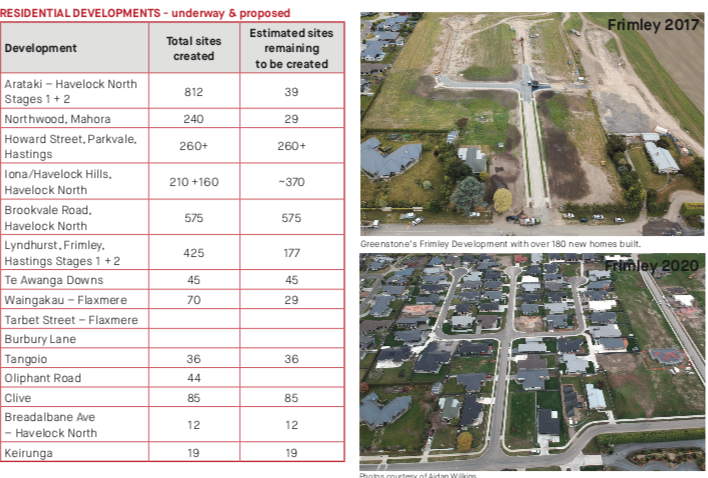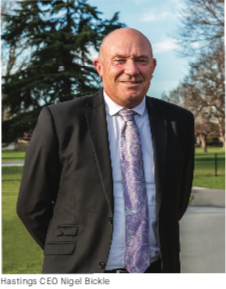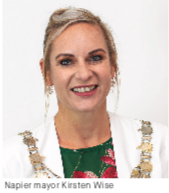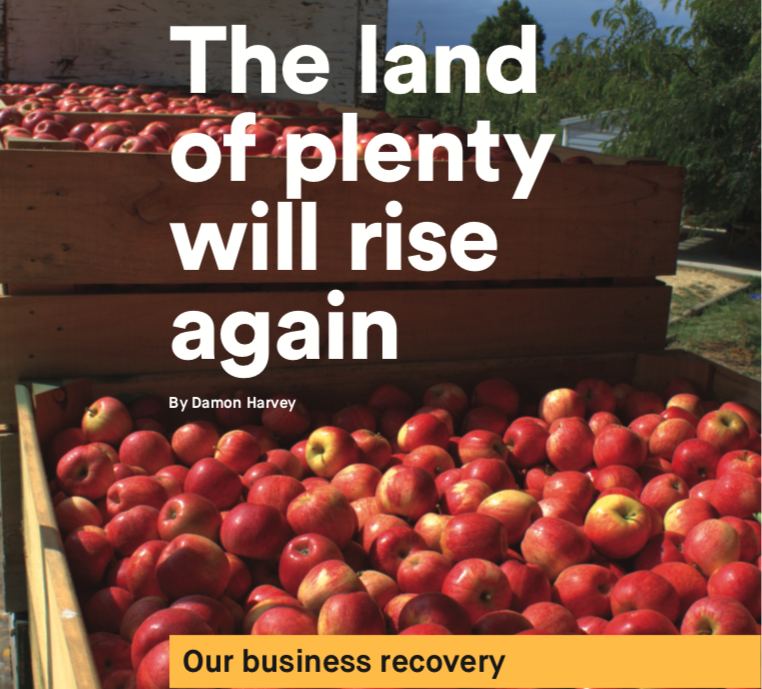Big things were expected from 2020. Hawke’s Bay’s economy was hot to trot and regarded as one of the strongest performing regions across New Zealand.
But, that all came to screaming halt on March 25 when Prime Minister Jacinda Ardern announced that businesses and schools across the country would go into lockdown and we would be forced to stay home for at least one month.

This was a huge jolt to the economy and we could already see the catastrophe that was taking place in other countries such as China and Italy.
The global stock markets went into freefall, dropping at levels not experienced since the GFC in 2007–08 and the Great Depression of 1929–33.
For Hawke’s Bay, many wondered whether all the good work that had been done in recent years to get the economy into such a strong position was going to come undone by COVID-19. We knew that hospitality and tourism were going to be the earliest COVID-19 casualties but what would be next?
Over recent years we have seen unprecedented levels of commercial, industrial and residential development across the Heretaunga Plains as well as in Napier City. Back in 2018, The Profit published a feature profiling over $600 million in construction work.
Meanwhile, our horticulture sector has also been booming, with new varieties planted and increased production; and the viticulture sector had perfect growing conditions that has winemakers calling it a vintage for the times.
The only blip for the region was in farming, which wasn’t based on price of product but a severe drought that has crippled farmers, especially those on the outskirts of Hastings and in Central Hawke’s Bay.
We’re now in a post-COVID-19 environment in New Zealand; we have all resumed our businesses and many of us are holding our breath to see what recovery looks like. For some, the journey is going to be long, longer than a cold winter; tourism is unlikely to get to the same levels for some years to come.
Local campaigns swarm the Bay
There’s been a lot of rhetoric about supporting local businesses first – buy local, shop local, travel local – and there’s been a multitude of support local campaigns, such as Hawke’s Bay Chambers’ Be in the Bay, hospitality’s Hawke’s Bay at Home, We are Team Napier, LocalEyes Hawke’s Bay, the list goes on …
Retailers in our CBDs have woken up to the fact that as well as having a physical retail presence, many have moved into the virtual world of e-commerce, not only selling to locals
but shoppers across New Zealand and the world.
The massive surge in online shopping saw courier businesses like Aramex (founded in Hawke’s Bay over 30 years ago) recording the equivalent of four Christmas parcel delivery periods between Levels 3 and 2, due to many small retailers creating shopify websites.
During the lockdown, The Profit interviewed 12 local business owners and managers. The 15-minute video interviews were a huge success and revealed several common observations: all of the interviewees were optimistic about their businesses’ futures; they believe our economy will recover quicker than other regions; and they regard our primary sector – produce that we grow from the land – as a unique asset that sets us apart from other regions.
Hastings was once known as ‘the Fruitbowl of New Zealand’ and some suggested that this continues to be our point of difference and our economic backbone – the apples, grapes, dairy and animals that prosper on our fertile land.
Major projects all go
One significant game-changing project already financially backed by $12 million of government funding is a Food and Innovation Hub in Tomoana.
The Hub is a cornerstone project of the Matariki Hawke’s Bay Economic and Social Strategy and aims to attract added value food technology and production as well as act as an incubator for new food producer businesses.
There’s also life in the commercial and industrial development scene with the likes of Rockit Apples’ multimillion-dollar packing facility in Irongate; a $70 million private hospital opposite the Hawke’s Bay Hospital; a new Kmart retail complex in Napier; and the final stage of the Toitoi – Hawke’s Bay Opera House.
An 50-strong call centre for Ministry of Social Development is also set to be established in Hastings. The airport’s $20.2 million terminal expansion is continuing and they are also promoting a $10 million solar farm; while Napier Port’s new wharf construction at a cost of over $170 million is well underway.
Housing at epicentre of recovery
Hawke’s Bay has had a dire need for new affordable housing and Kainga Ora (formerly Housing NZ) is willing to pump hundreds of millions of dollars into local housing solutions. As well as the government agency’s housing roll-out, there’s been record building consents in Central Hawke’s Bay, Hastings and Napier.
Hastings has several major housing developments including Lyndhurst in Hastings, Waingakau in Flaxmere, along with Arataki, Brookvale and Iona in Havelock North. Napier is continuing to develop housing in Te Awa, Mission Hills and Parklands. Retirement village developments are also boosting the economy with new developments in Havelock North and Napier.

CBD Retail transformation includes online presence
For many years long-established local retailers in our CBDs have come under pressure from big-box retailers as well as, more recently, global retail giants such as Amazon.
Many of these retailers haven’t moved with the times into setting up online websites, but COVID-19 forced some to do so and the benefits have been substantial.
The business associations of Hastings, Havelock North and Napier have been busy developing marketing plans for breathing life back into the CBDs. Hastings District Council has allocated $150,000 support for Hastings, Havelock North and Flaxmere campaigns and it will now be up to the retailers and hospitality providers to convert these efforts into sales.
Anita Alder, the general manager of Hastings Business Association says there is an air of optimism from retailers in Hastings. They’ve had tough times before and they’re a determined bunch of sales people.
“As for any SME, COVID-19 was tough and Hastings CBD was not immune to that; however, Hastings is back and businesses are focussed on driving forward.
“Our larger CBD recovery strategy kicks off at the start of July, assisted by funding from the Hastings District Council for CBD recovery and city developments, such as Tribune, and HDC future development/growth plans prior to COVID-19 are back underway.”
Anita says owners are thinking outside of the box, using their entrepreneurial skill sets to drive forward. Many local retailers since lockdown have included online sales and are seeing positive returns from that, while others used the lockdown period to their advantage, such as local bar The Common Room, which undertook a full refurbishment.
“While we are not fully out of the woods and have a way to go in the SME recovery process, we remain focussed and optimistic.”
Napier City marketing manager Pip Thompson said when lockdown was relaxed and retailers were able to reopen, they experienced a Christmas-like trade. Hotels and motels are increasing their trade weekly so all in all business is reasonably bright.
In Level 1 and beyond, Pip has launched a support local campaign, Buy Local–Win Local, with three $500 shopping sprees up for grabs.
“We visited all the retailers in the CBD when they reopened and they all have a very positive, optimistic outlook. They viewed the lockdown as ‘it is what it is’, and took the opportunity to work on their businesses and look at how they can do things differently.
“Many upgraded their websites and enhanced their online presence, which gives shoppers the ability to shop worldwide 24/7, while high-end restaurants took to the takeaway trade and enjoyed the change of service during Level 3.
“Most importantly, all of our retailers/retail assistants have big smiles on their faces and are glad to be back trading and welcoming people into their stores.”
Councils provide economic recovery stimulus packages
Hawke’s Bay councils have submitted a joint bid to Crown Infrastructure Partners for $314 million of government investment funds for ‘3 waters’ infrastructure projects, which includes stormwater, wastewater and drinking water while the Regional Council will appoint a Regional Recovery Manager to coordinate, support and lead economic recovery efforts.
Hastings District Council chief executive Nigel Bickle is keenly aware of the key role HDC has to play to regenerate and revive the local economy.

Nigel says that during lockdown Council was moving quickly to take advantage of government investment opportunities to help the region recover from the unavoidable economic downturn that would follow.
“Council invests well over $100 million per year to deliver services, maintain assets like our roads and develop critical infrastructure. A good chunk of that ends up as wages for employees of our suppliers and contractors, and that money is then in turn spent with businesses from supermarkets to shoe shops. We are a key stimulus to the economy.”
Following the call from government for ‘shovel ready’ projects, in just a matter of days Council pulled together applications not just for its own programme of work, but also in partnership with its fellow Hawke’s Bay councils.
“We already had 28 projects worth more than $16m that we could resume at Level 3, but this additional funding will help keep people employed and businesses alive without creating a huge rates demand on our community.”
The government responded positively to council’s funding applications and to date has committed to investing over $9 million in Hastings redeployment
opportunities (as part of a wider region allocation) to be used for local roading projects that will bring hundreds of new jobs into the region.
This will include $9.5 million to improve State Highway 51 around Waipatu Marae including upgrades to footpaths and iWays in the area.
Continued communication with key government agencies also saw the announcement of a $500,000 contribution towards drought relief that will benefit the district’s rural community, and the establishment of the MSD contact centre in Hastings.
Central Government has also pledged to invest in building 200 new homes in Hastings, where council is partnering with Kainga Ora to be just one of two cities in New Zealand to pilot a place-based approach to solving the current housing shortfall.
Napier ready to roll
Napier mayor Kirsten Wise says the development of our economic and social recovery and renewal framework for our community is well underway.

Council has a capital works programme in excess of $100m but has lost two potential major projects – the swimming pool complex, which has gone back to the drawing boards and no government funding for the national aquarium.
However this is partly offset with a new civic centre, a food processing plant at Awatoto and several residential developments. Napier is also the home of the Port and the Airport and this will continue to provide offshoot economic stimulus.
“So much is currently unknown about the extent of impacts and pressure points for Napier as we leave lockdown and venture into a new normal under Level 1.
“We want to be agile in responding to the needs of our community over the next 12-18 months. The framework will provide for agility and responsiveness in recovery initiatives, while ensuring that we remain focused on However this is partly offset with a new civic centre, a food processing plant at Awatoto and several residential developments. Napier is also the home of the Port and the our wellbeing goals; make decisions based on evidence; and partner with iwi, businesses, not-for-profits, and our community in the recovery and renewal journey,” Kirsten says.
Record council consents and PGF funding a positive hit for CHB
In Central Hawke’s Bay, the council has worked with its local government counterparts to pull together a list of ‘shovel-ready’ capital projects as part of regional stimulus packages to the Provincial Growth Fund (PGF) and Crown Infrastructure Partners (CIP).
The PGF package for Central Hawke’s Bay District Council (CHBDC) included 10 projects across areas such as roading, vegetation management, social housing, and walkways and cycleways, with a total value for these projects approximately $40 million.
The CIP package for the region focussed on three waters infrastructures, and CHBDC had six projects including domestic water supply and wastewater. The total value for these projects for CHBDC is approximately $89 million.
Council is also working with several commercial enterprises on large and medium-scale developments, some of which are applying for PGF funding. These projects have the potential for significant economic uplift for the district, both in their construction phase and ongoing contribution to our economy.
In April the council recorded a strong monthly high of $6.5 million worth of building consent applications lodged in April – a 180% increase on last year’s value for the same month and of a similar value to the $6.7 million worth of building consents lodged in March.
$15 million in projects to move Wairoa forward
Wairoa Mayor Craig Little says the district is continuing to push forward with millions of dollars’ worth of improvement and enhancement projects having received more than $15 million in additional central government funding through the PGF.
He says the investment is spread across the district in a range of building, construction and enhancement projects to support council’s aspiration to make Wairoa the best it can be.
“Our latest boost was around $2.5 million for roading and construction projects, which was part of the $15.24 million for Hawke’s Bay through the Government’s Worker Redeployment Package, announced in March.”
Wairoa work will see the replacement of the Patangata Bridge at Whakaki, realignment of the Nuhaka River Road at Nuhaka and repair of the Rangatahi Dropout at Mahia.
Other physical works include nearly $5 million for a town centre revitalisation project; $7 million towards the sealing of the Mahia East Coast Road; $2.2 million for bridge strengthening; and $400,000 for the creation of a regional digital hub in the Wairoa library.
A business case is also being conducted to look at all the options for access into the peninsula, and the realignment of the Nuhaka/Opoutama Road and access to Wairoa will further be improved with the $5 million funding for ‘pre- implementation’ work on the Waikare Gorge safety realignment project on State Highway 2 between Wairoa and Napier.
A series of non-council independent and iwi projects that directly relate to employment have also received PGF support.
“This work is just the beginning. Council continues to partner with local iwi and the Hawke’s Bay Regional Council on a range of vital projects that we hope will also receive Government support.”



